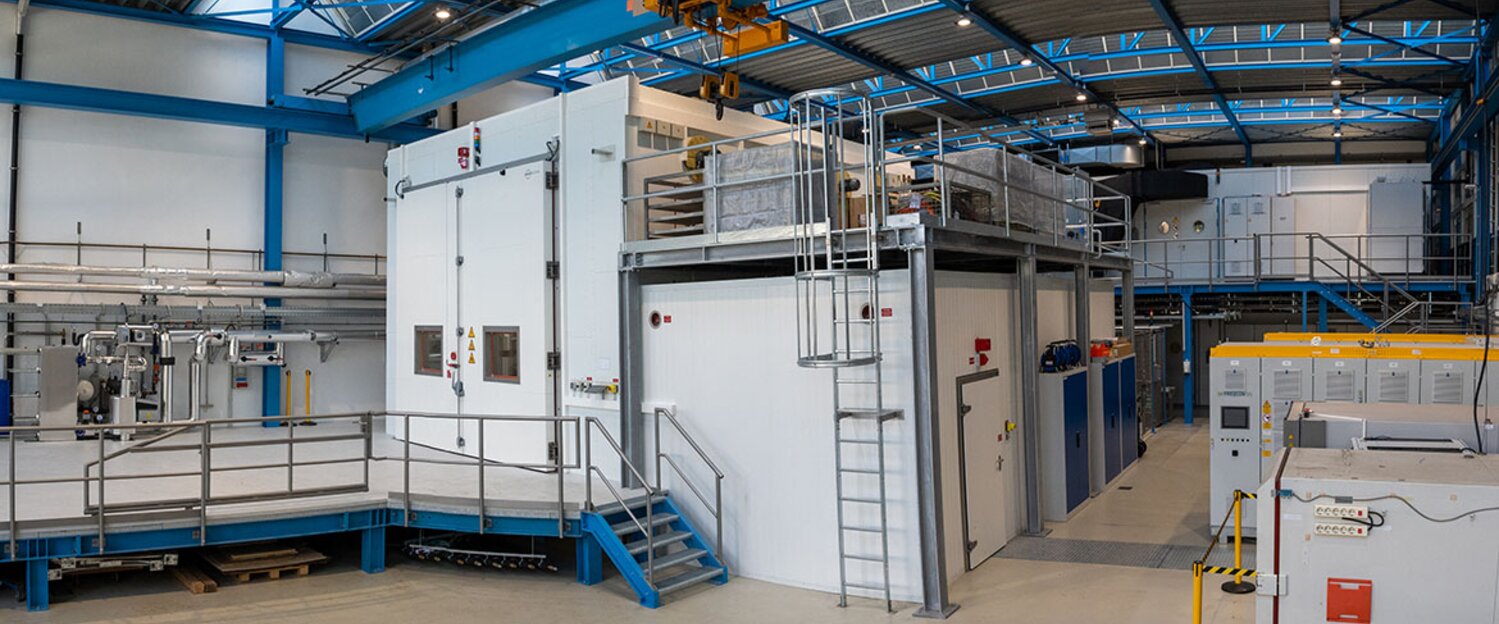Wind power makes an important contribution to combating climate change. However, breakdowns as well as maintenance and repair of wind turbines are usually time-consuming and costly. This often affects the power electronics, which are exposed to extremely high loads. This is why the University of Bremen is researching how to extend their service life and optimise maintenance as part of the joint project HiPE-WiND, funded by the BMWi. As part of this project, weisstechnik has planned and implemented a climatic test chamber for multidimensional load tests.
Partner for wind energy research
The joint project HiPE-WiND (High Power Electronics in Wind Energy Plants) is being led by the Institute for Electrical Drives, Power Electronics and Devices at the University of Bremen in cooperation with the Fraunhofer Institute for Wind Energy Systems in Bremerhaven. In order to find out which components of the power electronics fail under which conditions, long-term load tests are carried out on complete wind turbine converter systems up to the ten megawatt class. This simulates the high loads caused by changing wind conditions and the power grid under different climatic conditions - from the Arctic to the Sahara. All this is taking place in the customised climate chamber developed by weisstechnik. As the climatological heart of the "HiPE-LAB" in Bremen, the climate chmber helps to realistically and quickly recreate how the converter systems age under the multimodal loads during 20 years of use.
300 kW large-scale facility with heavy duty floor
As an experienced specialist in environmental technology, weisstechnik was able to successfully win the tender for the facility and plan and realise the project from a single source. The size and performance of the walk-in and drive-in chamber was a demanding task in itself, needing a usable test space volume of approx. 190 m3 and an electrical connected load of just under 300 kW. The surface load of the heavy-duty floor in the test space is more than 10,000 N/m2. The large test specimens - switch cabinets with converters - weighing up to 5,000 kg are moved into the test chamber on rollers via a double-wing door. The inner chamber walls are made of stainless steel (welded vapour-tight) and have a 200 mm thick 2-layer insulation consisting of special foam and mineral wool. A side door serves as access for the staff.
Environmentally friendly CO2 refrigeration system
The required temperature range for the tests is (-)40 °C to (+)120 °C. In order to realise this as efficiently and environmentally friendly as possible, a CO2 cascade refrigeration system was used. This means that temperatures down to (-)45 °C can be achieved with ease while at the same time enabling a high level of thermal compensation. This is important for the load tests because the test specimens tested under load generate a high thermal load. This is around 70 kW at 100 °C and a humidity range of up to 95% RH and 50 kW at 85 °C/85% RH. The use of CO2 as a refrigerant necessitates additional safety devices. It was therefore necessary to integrate a standstill cooling system with a separate power supply in order to prevent the CO2 from expanding and to avoid excessive system pressure during system standstill. In addition, a gas warning system is integrated in the test chamber and in the equipment compartment, which triggers visual and acoustic alarms and activates the emergency purge if CO2 escapes. Furthermore, the oxygen content is continuously monitored with redundant measuring technology.
Customised technology
Vertical air guidance was chosen to achieve a particularly homogeneous climate distribution within the test space. The pre-tempered air is fed into the test space from below via a heavy-duty double floor made of stainless steel perforated sheet metal (in which the connection lines for the test objects can also be laid), it is then fed through the heat exchanger and upwards. Under the ceiling, the air is laterally discharged and fed back into the air treatment room. The recirculation fans can be continuously adjusted and the humidity is realised hygienically via steam humidification. The equipment compartment next to the test chamber contains all the necessary aggregates and control cabinets. It was an important requirement that the sound level of the system must be below 72 dBA. The units were fitted with special sound insulation to ensure that this could be achieved reliably.
The system is controlled simply and intuitively via the tried and tested SiMPAC® controller, which has been optimised for environmental simulation systems and is the digital measurement and control system for operation, monitoring and documentation. The system can be operated via a touch panel (with the innovative WEBSeason® user interface) on the outside of the equipment compartment. In addition, the system can be operated in the convenient remote mode via an EtherCAT interface and network interface.
Environmental simulation technology for climate change
The multimodal test facility has been operating successfully in the HiPE WiND research project in Bremen since mid-2021. The resulting combination of realistic climatic and electrical load tests is perfect for determining how wind turbines can be made more robust and durable. Weisstechnik has therefore made another important contribution to the energy revolution.
871 words. Reprint free of charge. Please state Weiss Technik GmbH as a source.



